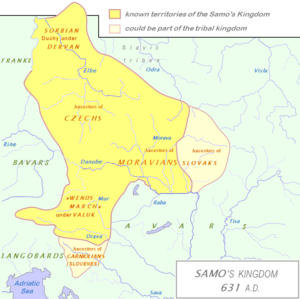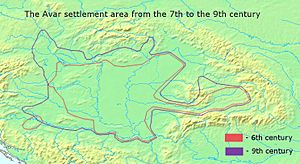Samo facts for kids
Quick facts for kids Samo |
|
|---|---|
| Rex Sclavorum ("King of the Slavs") | |

Alleged mural of Samo in a Moravian rotunda
|
|
| Reign | 623–658 |
| Predecessor | Title established |
| Successor | Title dismantled |
| Born | c. 600 "Senonian country" (Senonago), probably modern Soignies or Sens |
| Died | c. 658 |
| Spouse | At least twelve Wendish noblewomen |
Samo (born around 600, died around 658) was a Frankish merchant. He became the leader of the first known political group of Slavic tribes. This group is often called Samo's Empire or "realm." Samo ruled from 623 until his death in 658.
According to a writer named Fredegarius, Samo helped Slavic tribes. He united them against attacks from the Avars. Samo showed great courage and leadership in battles. Because of this, he was chosen as "King of the Slavs" (rex Sclavorum). In 631, Samo successfully defended his realm. He won a big battle against the Frankish Kingdom at a place called Wogastisburg.
Contents
Samo's Rule and Victories
Samo's rule began around 623 or 624. He ruled for about 35 years. The Slavs had been under the control of the Avars since the 560s. Samo might have been a merchant who sold weapons to the Slavs. They often rebelled against the Avars.
Samo took advantage of a major Avar defeat in 626. This helped him become a strong leader. He won many battles against the Avars. These victories proved he was useful to his people. They then chose him as their king. To make his rule even stronger, Samo married at least twelve noblewomen from the Wendish families. He had 22 sons and 15 daughters.
The Battle of Wogastisburg
The most famous event of Samo's rule was his victory over the Frankish army. This happened in 631 or 632. The Frankish king, Dagobert I, sent three armies to fight the Wends. His own army from Austrasia was the largest.
The Franks were defeated near Wogastisburg. This was a fortress whose exact location is unknown. Most of the Frankish soldiers were killed. The rest ran away, leaving their weapons behind. After this victory, Samo's forces raided Frankish lands. They attacked Thuringia several times. A Sorbian prince named Dervan also joined Samo's realm.
In 641, a rebellious duke from Thuringia, Radulf, formed an alliance with Samo. Samo also kept up trade with distant lands. However, after Samo died, his sons did not inherit his title. Samo is remembered for helping to create a strong Wendish identity. He spoke for the people who accepted his rule.
Learning About Samo
The main information about Samo comes from a Frankish book. It is called the Fredegarii Chronicon. This book was written around 660. It gives the best and only information about Samo from his time.
According to this book, Samo was a Frank from a region called pago Senonago. This area might be modern-day Soignies in Belgium or Sens in France. Even though he was Frankish, Samo made a Frankish ambassador wear Slavic clothes. This happened before the ambassador could enter Samo's castle.
Other writings about Samo came much later. They mostly used information from the Fredegarii Chronicon. For example, the Gesta Dagoberti I regis Francorum was written in the early 800s. Another book, the Conversio Bagoariorum et Carantanorum, was written around 871. This book said Samo was a Karantanian merchant. But this source is not as reliable.
Historians believe the writer of the Fredegarii Chronicon was very careful. He likely had good sources, maybe even eyewitnesses. One possible witness was Sicharius, the ambassador of King Dagobert I. The Fredegarii Chronicon says the Wends were subjects of the Avars. They were like a military unit for the Avar army. The book also tells the story of how the Wendish people began.
Some historians think the information came from Christian missionaries. These missionaries might have been students of Columbanus. This could explain why the book describes the Wends without common negative stereotypes.
Samo in Books
Not many stories or books are set during Samo's Empire. One recent book is Fire Worshipers, written by Vladimír Olej in 2018.
See also



